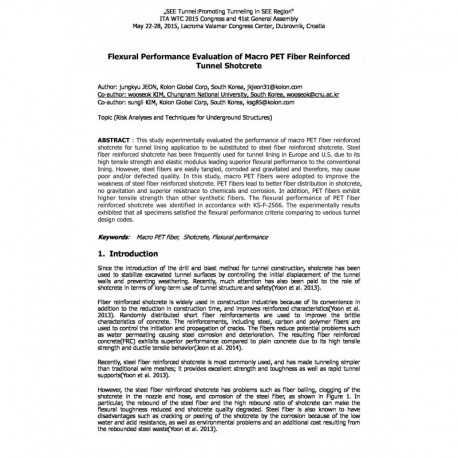Cart
0
0
No document
0,00 €
Total
Document successfully added to your shopping cart
Quantity
Total
There are 0 items in your cart.
There is 1 item in your cart.
Total documents
Total shipping
To be determined
Total
Search & filter
Search for a publication
Search & filter

Flexural Performance Evaluation of Macro PET Fiber Reinforced Tunnel Shotcrete
wtc2015_full_jeon-2
Since the introduction of the drill and blast method for tunnel construction, shotcrete has been used to stabilize excavated tunnel surfaces by controlling the initial displacement of the tunnel walls and preventing weathering. Recently, much attention has also been paid to the role of shotcrete in terms of long-term use of tunnel structure and safety(Yoon et al. 2013). Fiber reinforced shotcrete is widely used in construction industries because of its convenience in addition to the reduction in construction time, and improves reinforced characteristics(Yoon et al. 2013). Randomly distributed short fiber reinforcements are used to improve the brittle characteristics of concrete. The reinforcements, including steel, carbon and polymer fibers are used to control the initiation and propagation of cracks. The fibers reduce potential problems such as water permeating causing steel corrosion and deterioration. The resulting fiber reinforced concrete(FRC) exhibits superior performance compared to plain concrete due to its high tensile strength and ductile tensile behavior(Jeon et al. 2014). Recently, steel fiber reinforced shotcrete is most commonly used, and has made tunneling simpler than traditional wire meshes; it provides excellent strength and toughness as well as rapid tunnel supports(Yoon et al. 2013). However, the steel fiber reinforced shotcrete has problems such as fiber balling, clogging of the shotcrete in the nozzle and hose, and corrosion of the steel fiber, as shown in Figure 1. In particular, the rebound of the steel fiber and the high rebound ratio of shotcrete can make the flexural toughness reduced and shotcrete quality degraded. Steel fiber is also known to have disadvantages such as cracking or peeling of the shotcrete by the corrosion because of the low water and acid resistance, as well as environmental problems and an additional cost resulting from the rebounded steel waste(Yoon et al. 2013).


